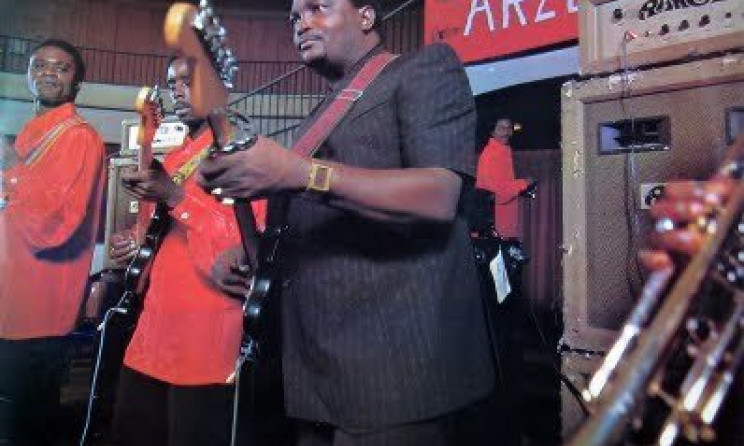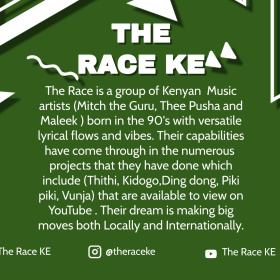A brief history of popular music in DRC
Key developments in popular music in the DRC, from its symbiotic relation with local politics and the global rise of Rumba.
 TP OK Jazz of Franco Luambo Makiadi. www.uscolorworks.com
TP OK Jazz of Franco Luambo Makiadi. www.uscolorworks.com
This text offers a brief overview of the history of popular music in the Democratic Republic of the Congo (DRC). It begins with a consideration of the influence of politics on popular music, specifically the role played by popular music in supporting and disseminating Mobutu’s Cultural Revolution. It then explores the rise of Rumba and the spread of Congolese popular music to the rest of the world, and ends with a look at more recent trends.
Popular Music Under Mobutu
The development of modern Congolese music and its spread throughout the world can be partially attributed to Mobutu Sese Seko Kuku Ngbendu wa Za Banga (1930-1997, b. Joseph-Désire Mobutu), who seized power on 20 May 1965 to become the country’s second president. This date also marked the birth of the Second Republic, renamed Zaire in 1972. Unlike the colonial administration, the new regime focused on the reconstruction of national politics and economics, social progress and the re-unification of a country that had been split by civil and ethnic wars since the dawn of independence on 30 June 1960. The beginning of the Second Republic also ushered in an era of cultural re-awakening that nurtured national unity and strengthened the national identity.
This era established a new feeling of patriotism in the population, embodied in the ideological slogans of the one-party state and the Movement Populaire de la Révolution (MPR), defined by its founder – Mobutu – as a family that was politically organized. People became indoctrinated in the cultural ideology of Recours à l’authenticité (Reaching out to Authenticity), pronounced by President Mobutu in 1971. The ideology reflected Mobutu’s determination to restore cultural values and self-esteem to the people and bring about national unity. This had strong ramifications in terms of society, politics, economics, arts, sport and music. The country began to prosper in certain areas, especially after Mobutu’s visit to Chairman Mao Zedong in China in 1974. That year the national soccer team, the Leopards, won the African Cup of Nations and qualified for the World Cup in Germany, while the historic ‘Rumble In The Jungle’ heavyweight boxing bout between Mohammed Ali and George Foreman was held in Kinshasa.
The re-awakening of the feeling of patriotism in the population that marked the Cultural Revolution was echoed in song lyrics that detailed the political realities of the period (1965-1975). Popular musicians embraced the new ideology and documented and exalted the accomplishments of the new regime. Urban music became a valuable vehicle of disseminating political throughout the nation. To Mobutu, the role played by popular musicians was an endorsement of his authority and power. Music was a vital tool for the success and survival of his Cultural Revolution. The first decade of the Second Republic was a period of unprecedented developments, including a rapid rise in the number of young musicians, particularly in ensembles that revolutionized local music by incorporating traditional melodies, rhythms, harmonies and dance movements into their compositions.
In order to understand the significance of this change, one needs to consider certain phenomena beyond the music scene. For example, the education system inherited from the colonial period and implemented in Congolese schools had shortcomings in its objectives, some of which are at the root of the nation’s social problems. The quota system, compounded by uncontrolled population growth in urban centres and the government lack of a clear educational policy, left more than one generation without the chance to gain an education beyond primary school. The meagre options available to boys included becoming a low-paid laborer, living on the streets as a shegue (street child) or kuluna (bandit), becoming a soccer player or a soldier. Females could live on the streets, get married or become a prostitute or concubine of a wealth politician or businessman. Alternatively, music offered greater opportunities for wealth and success.
Congolese Rumba
An examination of Congolese rumba reveals that what evolved into a popular urban genre in DRC is not the Cuban music also called rumba, but instead a variant of the intertribal African music and dance called maringa. The name rumba was maintained in DRC by the recording industry for commercial reasons. Recording studio owners re-interpreted the term by incorporating new maringa rhythms but keeping the name.
The first variation of the Congolese rumba is called soukous, a name probably derived from the French verb secouer (to shake), began to be used as a generic term to designate the Congolese urban dance music style that conjures up movements of Luba traditional dance called mutwashi. Soukous is the name of the mid-60s rumba variant marking the first stage of the evolution of the Zairean rumba. Other rumba variants, also modeled on traditional dance movements, were subsequently introduced in Kinshasa. In 1971, singer Lita Bembo and his Stukas Ensemble introduced the dance ekonda saccadé that reflected the strong influence of Mongo culture. Five years later, another variant of Congolese rumba, called mokonyonyon, was introduced by singer Shungu Wembadio (better known as Papa Wemba) and his ensemble Viva la Musica. Movements of the mokonyonyon dance emulated the pelvic thrust dance movements from the singer’s Otetela ethnic background. These are but a few of the Congolese rumba variants that contained elements of traditional dance movements that dominated the first decades of the Second Republic.
Mobutu relied on the productivity of urban musicians to serve the revolution. Song lyrics written during this period (1965-1975) contained themes of pride and stressed cultural and political philosophies pronounced by President Mobutu in his numerous speeches. For example the song ‘République du Zaire’, composed in 1970 by Munsi Jean (also known as Kwamy) and interpreted by Franco Lwambo Makiadi and TP OK Jazz, calls upon the population to support Mobutu in all that he is doing, especially in choosing Zaire as the new name of the country. The refrain of the song is divided into two segments. To express his pride for the country, Kwamy outlines the course of the Congo River in these words, translated into English:
Zaire River started in Katanga, Kivu and Upper Zaire
Equator passed to Bandundu
Bandundu passed to Kinshasa
Kinshasa sent to Lower Zaire
And Lower Zaire to the ocean
The second segment of the song lists numerous national landmarks, underlining the sense of pride that Mobutu attempted to instill in his people.Several landmarks are mentioned, such as a presidential conference centre and resort (Nsele); a goldmining project (Kilo-Moto), one of the largest electrical dams in Africa (Inga), a hospital ship that attended to sick people in remote areas (Bateau ya Hopitalo) and Africa’s Large Drum (Grand Tamtamd’Afrique), a statue of a drummer at the entrance of the fairgrounds that staged the International Fair of Kinshasa in 1969. The song concludes with a call of admiration for the leader: “We are especially happy that you gave us Mobutu”.
Another powerful song from this period is ‘Belela Authenticité nakatiya Congress’ (‘Declare authenticity in the congress’) written by Franco Luambo Makiadi and his TP OK Jazz band in 1970. The song urges a sense of personal belonging to the country in an attempt to foster national identity. Speaking about the song in an interview, Franco stressed that he is a musician who observes the politics of his country and sings about it, just as a newsman will write about the politics of his country without being called a politician. In the song, after calling attention to the essence of the revolution, the composer proudly concludes the song with praises to Mobutu, referring to him as the head of the family and emphasizing the concept of belonging in these terms, again translated into English:
In a foreign country,
If a stranger should ask me, ‘Who am I?’
Proudly, in my own way,
I will tell him:
I am Zairean.
My political party is MPR.
My chief is Mobutu Sese Seko
The song thus promotes the idea that one’s personal identity is defined by his or her country (Zaire), family (MPR) and father (Mobutu). As a result of the president’s appeal, several projects were carried out under the direct supervision of the office of the president. Activities at the Institut des Musées Nationaux included the publication of Art of Africa: Treasures from the Congo (edited by Frère Joseph Cornet) and culminated in the purchase and exhibition of 17th century costumes and drums belonging to the lineage of Kuba kings at the 1973 meeting of the International Association of Art Critics in Kinshasa. In the domain of urban music, the president’s appeal brought about several major projects of national interest, such as the foundation of the Zairean Musicians Union (Union des Musiciens Zaïrois - UMUZA) in 1971, the release of the Anthology of Modern Zairean Music in 1974 and the creation of the Prix National de Musique (renamed Prix Grand Kalle in 1984 in honour of the late bandleader Joseph Athanase Tchamala Kabaselleh, known as ‘Le Grand Kallé’).
Congolese Music Goes Global
The downfall of the recording industry in the country, due to political and economic factors, forced a massive exodus of musicians to capital cities in Africa and Europe, where many were forced to work as session musicians. Concert tours by ensembles and individual musicians were also instrumental in disseminating urban Congolese music to the rest of the the continent and its diaspora. For example, Congolese musicians performed in Kenya, Tanzania, Uganda, Zambia, as well as further afield in Sierra Leone, Liberia, Europe and Asia. Describing the musical scene in Kenya, for example, musicologist Doug Paterson wrote in 1994: “Congolese musicians have been making musical waves in Kenya since the late 1950s. But it wasn’t until the mid-1970s, after the passing of the American soul craze, that music from Zaire (DRC) began to dominate the city nightclubs.”
Of all the traveling Congolese bands, none contributed more to the global awareness of Congolese music than the quartet called Ry-Co Jazz (Rythme Congolais). The band was formed in 1958 by one of the leading musicians in Kinshasa, Henry Bowane, as a makeshift ensemble for Christmas and New Year’s shows in Bangui, capital of the Central African Republic. Ry-Co Jazz was originally made up of a mix of musicians from the two Congos: singers Freddy Nkounkou and Mbilia Casino, guitarist Pierre Ndinga, bassist Panda Gracia, clarinetist Fidel Bateke and Pierrot on congas. During the 14 years of its existence (1958-1972), Ry-Co Jazz performed to packed bars and clubs throughout West Africa, the Caribbean and France. While on the Caribbean island of Guadeloupe, Ry-Co Jazz recorded their songs with producer Henri Debs at his studio and soon flooded the Caribbean with Congolese music.
By the end of the 1980s, a large number of Congolese musicians were living in Europe, sometimes supplementing their bands with local musicians and others who they trained to play in the Congolose style. An excellent example of the backing band that traveled and recorded with Paris-based Congolese musicians such as Kanda Bongo Man and female singers Tshala Mwana and Yondo Sister. One remarkable example of the globalization of the Congolose music was the group of Japanese musicians who spent time in Kinshasa in 1984 learning Congolese urban music. Congolese lead guitar players became a hot commodity sought after by bands from various parts of the world to add a Congolese flavor to their music or teach local musicians the art of Congolese guitar playing. Arguably the most significant example in this regard is Diblo Dibala, who featured on the 1994 album Fogarate by Juan Luis Guerra and his renowned band Cuatro Cuarenta (4-40) from the Dominican Republic.
By Kazadi Wa Mukuna




















Comments
Log in or register to post comments